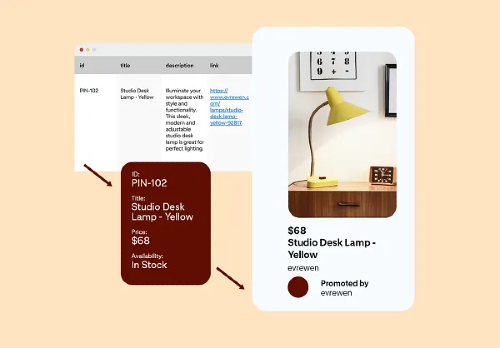Message Over Medium
💬 The Art of Building Ads Backwards, Maximize Pinterest Performance+ Ads, and more!

Hey there Smarty 👋
Are you geared up to catch the latest and greatest in quick shorts?
And just a quick heads-up! If you stumbled upon us through a friend, make sure to subscribe here! That way, you’ll never miss out on the trending shorts.

💬 Message Over Medium: The Art of Building Ads Backwards
Most brands build ads like trailers—lead with visuals, slap copy on top. But in today’s performance landscape, that’s backwards.
The smartest brands write their ads before they design them. Because in the noise of endless scrolls, it’s not the edit that stops the thumb—it’s the sentence. The hook. The oddly specific reframe. The message is the ad.
Why Message-First Always Wins
When you analyze top-performing UGC, it’s rarely the lighting or transitions that convert. It’s a thought. A sentence. A shift in belief.
Obvi’s team built their best-performing Meta ad around one line: “Your grandma’s collagen, reinvented for your knees.” The result? A 3.6x ROAS improvement, 40% higher video hold rate, and a campaign that spun into six new angles—all from one idea.
To build Message-First Ads that scale:
✅ Start With the Sharpest Sentence
Forget benefits and slogans. What one sentence would reframe your customer’s worldview in three seconds?
→ Example: “Most skincare tries to fix your face. Ours works with it.”
That’s the thought. The design comes after.
✅ Isolate the Emotional Payload
Great messages trigger identity, desire, or fear.
Ask: What belief does this message challenge or confirm? If it doesn’t strike a nerve, it won’t stick. Strip it down until it does.
✅ Match the Medium to the Message
If your message is intimate, use a lo-fi selfie cam. If it’s bold, go full-screen with kinetic text.
Your format should amplify the message—not distract from it.
✅ Iterate the Thought, Not Just the Creative
Don’t rotate visuals blindly. Re-angle the message itself:
→ Add contrast: “It looks like coffee. It’s better.”
→ Add tension: “We made a mattress that solves your marriage.”
→ Shift the POV: “What your joints would order if they had Amazon.”
Strong hooks typically show 3–4x higher hold rates in the first 3 seconds vs. design-first ads. Write for that signal.
The best ads aren’t the prettiest. They’re the clearest.
Design doesn’t sell—it supports the sentence that does.
Start with the thought. Build around it.
The brands that win don’t shout louder. They resonate deeper.

Together with Neurons
Will people remember your ads? Find out before you go live
Creating attention-grabbing ads is one thing. But making ads people actually remember?
Neurons AI helps you out with both.
Predict how your ads will perform before launch, measure whether your audiences remember your ad days after seeing it, and if it evokes positive emotions.
In other words, before spending a cent on your campaign, you get:
- Instant, actionable recommendations to improve your creatives.
- Memory and engagement estimations.
- Overview of how engaging each element of your creative is.
- Suggestions that can boost performance, based on insights from thousands of campaigns.
It gives you quick, actionable recommendations to improve your creatives and maximize your ad impact. Run A/B tests before launch and tweak your visuals for maximum brand impact.
Major brands like TikTok, L'Oreal, and Google are seeing up to 73% boosts in CTR and 20% jumps in brand awareness.
Get Neurons & Start Improving Your Ads Today!

📌 How to Maximize Pinterest Performance+ Ads
Insights from Pinterest
Pinterest’s Performance+ is its AI-powered ad suite designed to simplify campaign creation, targeting, and bidding—similar to Meta’s Advantage+. With marketers seeing up to 20% lower CPA and 50% less manual setup, Pinterest has now shared key tips to get the best results from it.

The Breakdown:
- Track Smarter, Optimize Faster - Integrate both the Pinterest Conversions API and Pinterest Tag to feed stronger data into the system. This boosts signal accuracy, leading to better targeting and attribution.
- Feed the AI Right - Optimize your product feed with detailed metadata, keyword-rich titles, and well-structured groupings. Also, match your objective to your conversion volume—use Consideration campaigns if you don’t yet have high conversions.
- Go All-In on Creative Variety - Use at least 10 ads per Ad Group, mixing formats like Video, Standard, Collections, Carousel, and Idea Ads. Each layer in Performance+ (like creative tuning and ROAS bidding) works together to improve results.
- Be Patient, Then Test Aggressively - Give the algorithm two weeks of a high enough budget (5x your CPA goal) to learn. After that, experiment—try different landing pages, formats, CTAs, and pause what’s underperforming.
With 553M users and strong shopping intent, Pinterest is a powerful platform—especially when AI handles the heavy lifting. These tips help brands unlock better performance with less manual effort.

🚀 Quick Hits
❓ Struggling With Influencer Collaboration? Insense connects you with top UGC creators in minutes and handles everything from briefs to campaign execution. Get high-impact content for TikTok, Meta, and more—delivered in 14 days. Book a free call now & claim $200 for your first campaign!
🔍 Meta is quietly rolling out more features for user-created AI chatbots across Facebook, Instagram, WhatsApp, and Messenger. Users can now assign custom voices to their bots via AI Studio, with a growing library of categorized voice options for tailored personalities.
📌 Google is adding search term visibility to Performance Max campaigns, allowing advertisers to view queries in the Search Terms report and add negative keywords directly boosting transparency and control, addressing key concerns around PMax’s previously opaque targeting system.
🛍️ Starting April 21, 2025, Google Merchant Center will align its click reporting with Google Ads. This change means only ad clicks—not all interactions—will count as product clicks, potentially altering historical data but not actual ad performance.
📚 Gen Z is rewriting the rulebook on search. Instead of Google, they’re turning to TikTok, Instagram, YouTube, and Reddit for recommendations, reviews, and how-tos. A 2024 Forbes study shows Google usage is 25% lower among Gen Z than Gen X, with 46% preferring social platforms for search.

That’s a wrap for today! Tell us your thoughts about today's content as we line up more Shorts! And don’t hesitate to share this with someone who’d adore it. 🥰
